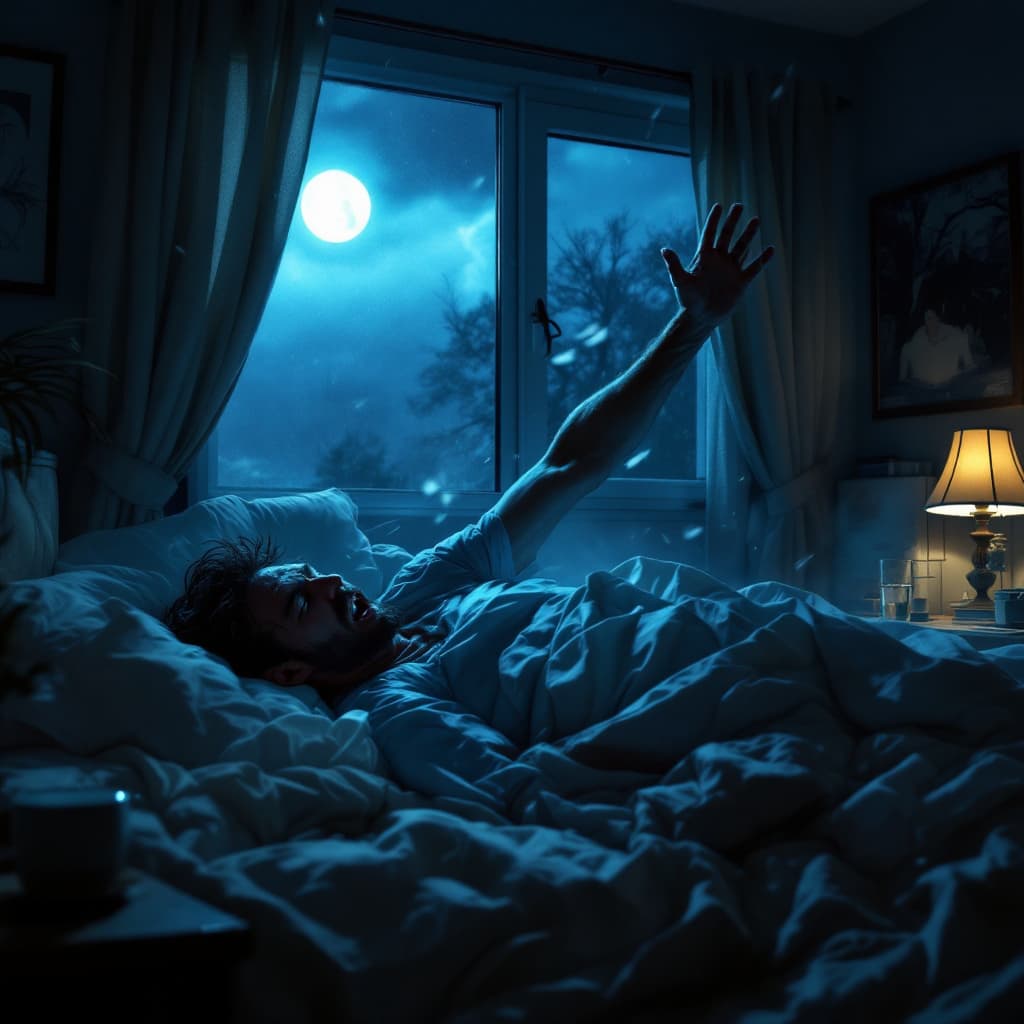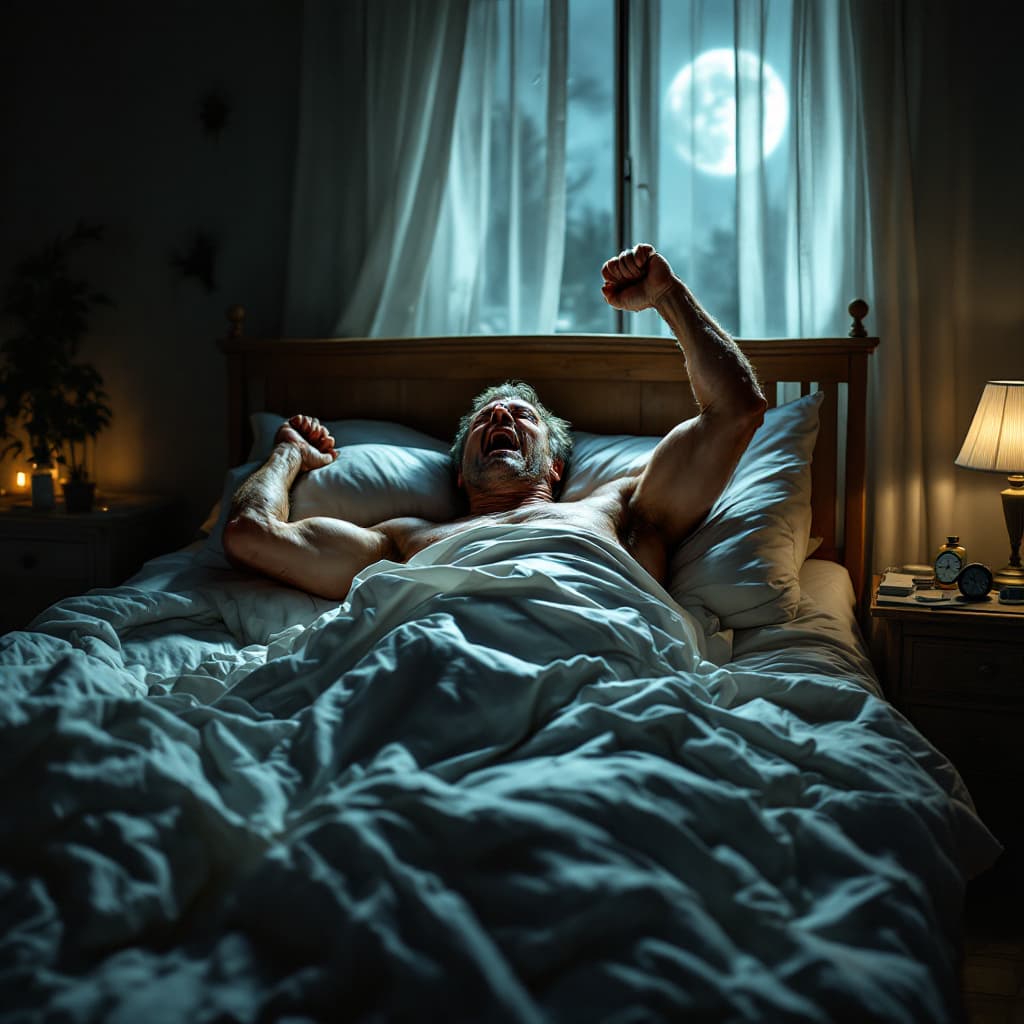Warning: Use of undefined constant gia_tien - assumed 'gia_tien' (this will throw an Error in a future version of PHP) in /www/wwwroot/khoahocautocard.edu.vn/wp-content/themes/nha-hang/template-parts/posts/content-single.php on line 2
Warning: Use of undefined constant gia_khuyen_mai - assumed 'gia_khuyen_mai' (this will throw an Error in a future version of PHP) in /www/wwwroot/khoahocautocard.edu.vn/wp-content/themes/nha-hang/template-parts/posts/content-single.php on line 3
Ever wake from a wild dream to find the sheets in a heap, your heart racing, or a new bruise you can’t explain? If your nights feel chaotic, you might be seeing signs of something more than restless sleep.
RBD Sleep Disorder is a condition where you act out your dreams during REM sleep, sometimes with shouting, kicking, or punching. In normal REM sleep, your muscles stay relaxed. With REM sleep behavior disorder, that off switch does not work, so your body moves with the dream.
This matters for two big reasons. First, it can cause injuries to you or a bed partner. Second, it can be an early warning sign of neurological disease, including Parkinson’s disease. That sounds scary, but there is real help, and getting answers early makes a difference.
Here, you’ll learn what RBD Sleep Disorder is in plain language, how to spot common symptoms, and what tends to cause it. You’ll see how doctors diagnose it, often with a sleep study, and what treatments can calm the nights, like safety steps, medication, and daily habits that support better sleep.
If your dreams feel dangerous or out of control, you are not alone, and you are not stuck. Keep reading to learn what to watch for and how to get the right care.
What Exactly Is RBD Sleep Disorder?
RBD Sleep Disorder is a condition where your body does not stay still during REM sleep, so you move with your dreams. In normal REM sleep, your brain is active, your eyes dart, and your muscles switch into safe mode, which is near paralysis. Sleep cycles repeat about every 90 minutes, and REM gets longer later in the night. With RBD, that brake fails. It is like an actor stepping off the screen and into the fight scene. About 1% of older adults are affected, though it can start earlier. It looks scary, but it is treatable.
The Role of REM Sleep in RBD
REM is the dream stage. Your brain runs fast, your breathing changes, and your muscles should stay relaxed. That stillness is called REM atonia, and it keeps you from acting out dreams. In RBD, the atonia drops out. Your body follows the script of the dream, so you may kick, punch, shout, or leap from bed. This can happen many nights, often in the second half of the night when REM is longer. You might wake remembering a vivid chase or fight and find the bedding on the floor.
Try simple tracking at home to spot patterns:
- Keep a brief sleep diary with bedtimes, awakenings, and any injuries or noises.
- If safe and agreed upon, use a bedside audio recorder or smartwatch notes to capture events.
How RBD Differs from Nightmares or Sleepwalking
Nightmares wake you scared, but your body stays still. You might gasp or sit up, then settle. Sleepwalking happens in non-REM sleep. It looks like quiet, confused wandering with poor recall later. People rarely act out vivid plot lines during sleepwalking.
RBD is different. It happens in REM, pairs with vivid, often violent dreams, and you usually recall the story. Movements match the dream, like punching during a fight scene. Misdiagnosis is common because bed partners see movement and assume sleepwalking or night terrors, and PTSD nightmares can look similar. Do not guess. A sleep specialist can confirm RBD with an overnight study and guide safe, effective treatment.
Common Signs and Symptoms of RBD Sleep Disorder
RBD Sleep Disorder shows up most clearly in how you move and speak during sleep. It often starts after age 50, yet it can affect younger people with certain conditions or medications. Spotting patterns early prevents harm to you and your bed partner.
Physical and Vocal Symptoms to Recognize
With RBD Sleep Disorder, your body acts out vivid dreams, often with a fight or chase theme. Movements can be sudden and strong, not gentle tossing. You might see:
- Thrashing limbs or punching, as if blocking or striking.
- Kicking or falling out of bed, sometimes hitting furniture.
- Jumping, grabbing objects, or running motions while lying down.
- Yelling, screaming, cursing, talking loudly, or laughing in sleep.
Events tend to occur about 90 minutes after you fall asleep, during bursts of REM. They often cluster in the second half of the night when REM periods lengthen. Many people recall a matching dream upon waking, such as fighting off an attacker or fleeing danger. Despite the chaos, you may feel fairly refreshed on waking, unlike insomnia or sleep apnea. Any bruises, cuts, or injuries to you or a partner are red flags. Track dates, times, and triggers in a simple log to spot trends.
When Symptoms Might Indicate Something More Serious
RBD Sleep Disorder can be more than a sleep issue. For many people, it is an early sign of a neurodegenerative disease, often one tied to alpha-synuclein. This includes Parkinson’s disease, Lewy body dementia, or multiple system atrophy. Research shows that up to 80% of people with long-standing, unexplained RBD may develop a related neurological condition over time. That number is high, yet it does not mean you will get one.
See a sleep doctor or neurologist if symptoms persist, worsen, or cause injury. Seek care sooner if you also notice changes in smell, constipation, stiffness, subtle tremor, or mild forgetfulness. Bring a sleep log and, if possible, your bed partner’s observations. Early evaluation leads to safer nights, protective home changes, and proper follow-up. Even if no disease appears, you can still treat RBD effectively and reduce risk.
Causes and Risk Factors Behind RBD Sleep Disorder
RBD Sleep Disorder often starts when brainstem signals that keep muscles still during REM sleep misfire. Some causes are medical, others are lifestyle. Knowing where you fit helps you act early and stay safe.
Medical Conditions That Increase Your Risk
Several neurological conditions raise the chance of RBD Sleep Disorder. The link is strongest with Parkinson’s disease, multiple system atrophy, and Lewy body dementia. RBD can show up years before movement or memory symptoms. Stroke can trigger RBD if it affects brainstem pathways. So can narcolepsy, which disrupts REM control.
Less often, other brain problems can spark RBD. These include:
- Traumatic brain injury, even a concussion from a car crash or fall.
- Autoimmune inflammation, such as autoimmune encephalitis.
- Brain tumors, especially near the brainstem.
- Central nervous system infections, like encephalitis or meningitis.
Picture this: you had a head injury last year. Your dreams turned vivid, you started flailing, and now you wake sore. That shift matters. It points to changes in the brain’s REM “off switch.”
This list sounds heavy, but it gives you power. If you have one of these conditions, tell your doctor about dream enactment, new injuries in sleep, or a bed partner’s reports. Early evaluation can prevent harm, guide safer sleep plans, and set up the right follow-up with neurology.
Lifestyle and Environmental Triggers
Some habits and medications can worsen RBD Sleep Disorder or mimic it. Alcohol before bed lowers muscle control and causes REM rebound later in the night. Several antidepressants (like SSRIs or SNRIs) can increase dream enactment. Poor sleep habits also feed it. Irregular bedtimes, late-night screens, and sleep deprivation all push REM instability.
Action steps that help:
- Skip alcohol within 4 to 6 hours of bedtime.
- Avoid late caffeine, energy drinks, or nicotine after mid-afternoon.
- Review antidepressants or other REM-active drugs with your clinician.
- Keep a steady sleep schedule and a dark, quiet bedroom.
Genetics can matter. Some families show a higher risk, especially when paired with neurological disease. Other risk factors include age over 50, male sex, family history, and narcolepsy. Stress and new medications can tip you over the edge. Track changes in a simple sleep log, then share it with your doctor to pinpoint triggers and tailor care.
Diagnosing and Managing RBD Sleep Disorder Effectively
If you suspect RBD Sleep Disorder, you can take clear steps to get answers and feel safer at night. Diagnosis is straightforward, and treatment works well for most people. Start with a plan, then build a safe sleep setup while you wait for care.
Steps for Getting a Proper Diagnosis
Begin with your primary doctor or a sleep specialist. Share a simple sleep diary for two to four weeks. Note dream enactment, injuries, sleep times, new meds, and alcohol use. If you have a bed partner, ask for their observations.
Expect an overnight polysomnography in a sleep lab. This test records brain waves, breathing, heart rhythm, muscle activity, and video while you sleep. Staff place small sensors on your scalp, face, and legs. It is painless, non-invasive, and setup takes under an hour. You sleep as usual and go home early in the morning.
Why the lab? RBD is confirmed when REM sleep occurs without normal muscle relaxation, paired with congruent behaviors on video. Some centers use home video, smartphone clips, or actigraphy as helpful screening tools. These can guide care, but a lab study with video and EMG is still the gold standard. Most people feel relieved once they see clear results and a path forward.
Treatment Options and Long-Term Management
Most people improve quickly with a mix of medication and safety steps. Common choices include:
- Clonazepam at bedtime to calm movements.
- Melatonin to improve REM control and reduce injuries.
- Addressing triggers, such as alcohol near bedtime or REM-active drugs.
Create a safer bedroom right away. Move sharp furniture, pad corners, lower the bed, and place a soft mat on the floor. Consider sleeping in separate beds or rooms during flares to protect both of you. Treat underlying issues like sleep apnea, PTSD, or restless legs, since they can worsen symptoms.
Stay in touch with your clinician. Periodic checks for signs of Parkinson’s disease or related conditions are wise. With the right plan, over 90% of people reduce dangerous events and injuries. You can regain calm, predictable nights and wake up feeling safe again.
Conclusion
You have learned that RBD Sleep Disorder is serious, yet very manageable. Awareness, a proper sleep study, and simple safety steps reduce harm fast. Medicines like melatonin or clonazepam can calm movements, and steady sleep habits help. Many people go back to quiet nights, steady mornings, and normal days.
If your dreams feel dangerous, act now. Talk with a sleep specialist or neurologist, share a brief sleep log, and bring a partner’s notes. Early care prevents injuries, and it can reveal related issues sooner, like Parkinson’s disease or sleep apnea. That head start matters, because it guides safer choices at home and at work.
Do a quick home safety sweep tonight. Clear sharp edges, lower the bed if you can, add soft mats, and consider separate sleep space during flares. Skip alcohol near bedtime, keep a steady schedule, and review medications that may stir up REM sleep.
You can live well with this condition. Most people who get diagnosed and treated see strong improvement, often within weeks. Stay connected with your clinician, and set follow-ups to track any new symptoms. Keep your plan simple, and update it as your needs change.
Share your experience in the comments, or pass this guide to someone who needs it. If you have active symptoms, schedule a consult today. Your sleep can be safe, your days can be steady, and your next step starts now.
